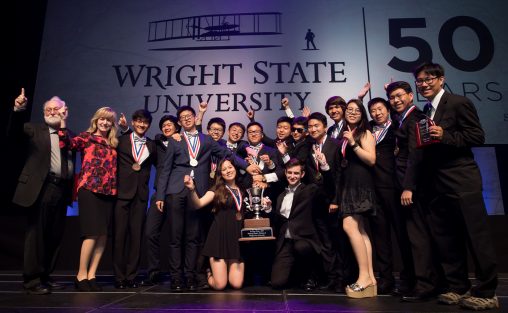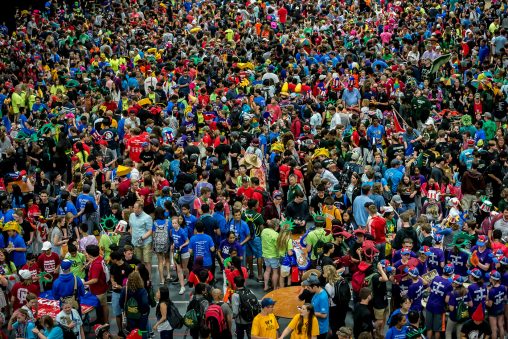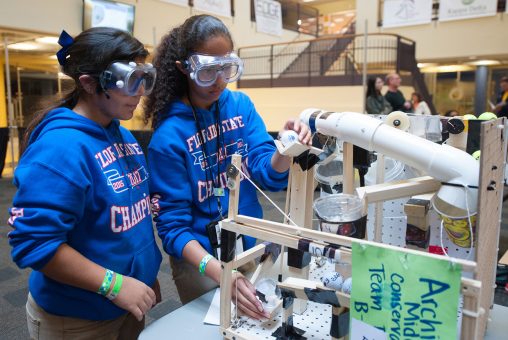
Teams from Troy High School in Fullerton, California (pictured), and Daniel Wright Junior High School in Lincolnshire, Illinois, took top honors in the 2017 Science Olympiad National Tournament at Wright State. (Photos by Erin Pence, Will Jones, Chris Snyder and Matt Helton)
They arrived at Wright State University from the East Coast, the West Coast and everywhere in between, bringing their science skills and talents in hopes of being declared the best in the land.
About 2,000 middle and high school students battled it out May 20 in intensely competitive science and engineering projects — from Robot Arm and Hovercraft to Microbe Mission and Food Science — as part of the 2017 Science Olympiad National Tournament.
Teams from Troy High School in Fullerton, California, and Daniel Wright Junior High School in Lincolnshire, Illinois, took top honors.
“These winning teams exemplify the best America has to offer in science, technology, engineering and math,” said Gerard Putz, Science Olympiad president and co-founder. “We are proud of their incredible achievements and know their schools and communities will welcome them home like champions.”
The students, educators and parents from all 50 states totaled more than 5,000 — pumping an estimated $1.7 million into the local economy.
The Science Olympiad kicked off at the Wright State Nutter Center the evening of May 19 with the Parade of States, an Olympics-like cavalcade of teams cheerleading their home states by wearing everything from red, white and blue patriot hats to ear-of-corn headgear to sponge wedges of cheese.
The next day, competition unfolded across campus, in classrooms, parking lots, the Student Union and the Student Success Center.
In the Health Sciences building, the Towers competition featured students who had constructed what looked like miniature oil derricks made of balsa wood. Judges would see how much weight the towers would support, taking most of them to the breaking point and filling the room with loud “cracks” as the towers fractured.
Students, coaches and parents looked on from theater seats in the auditorium.
“There are a lot of engineering designs that go into the tower,” said Shrivathsa Ballal, whose son was competing with the Liberal Arts and Science Academy from Austin, Texas.
Ballal said he was impressed with Wright State’s tunnel system and swelled with pride when he learned that several major donors with buildings and halls named after them hailed from his native India.

Science Olympiad brought more than 5,000 students, educators and parents from all 50 states to Wright State, pumping an estimated $1.7 million into the local economy.
David Walker, coach of the Austin team, said it has become especially difficult in Texas to get to the national tournament in recent years.
“So simply making it to this tournament is a reward in itself for these kids,” he said. “And they’re super pumped.”
Walker said the hardest thing about performing at Science Olympiad is making sure the team doesn’t bomb an event, which can dramatically lower the overall score.
“The greatest strength of this year’s team is its consistency,” he said.
Also taking part in the Towers competition was Tower Heights Middle School from Centerville, Ohio. The team also competed in the bottle rocket, hovercraft and other events. The other Ohio teams were from Mentor High School and Solon middle and high schools.
Tower Heights finished 17th in its division. Solon high and middle schools both finished third in their respective divisions. Mentor High School won a DuPont Team Enterprise Award, recognizing a breakout performance by a team at the National Tournament.
For the bright, young Science Olympiad students, the national tournament is a launching pad. Many will go on to top universities, where they will feed their natural curiosity, advance their research skills and sharpen tools that will shape the future of science.
Wright State Provost Thomas Sudkamp said the university couldn’t be more thrilled to host the best and brightest middle and high school students.
“We have seen many of your great young minds at work during the invitational competitions held at Wright State University,” Sudkamp said. “Your ingenuity, innovation and sheer brilliance are beyond compare. It makes me feel very positive about the future of this country when I see such genius in the next generation.”

Science Olympiad tests middle and high school students’ ability to solve physics, engineering, math, biology and anatomy problems in complex hands-on and lab events.
Winners of the Science Olympiad were offered scholarships to Wright State. All official members of the first-place team in Division B and Division C will receive a $2,500 scholarship, renewable for four years. In both divisions, the university will also award $1,000 scholarships to the first-place winners of each individual event, also renewable for four years. All awards are subject to admission requirements.
The school-based teams prepare and practice throughout the year, then compete in regional and state tournaments. The top 120 teams from state competitions advance to the national tournament. Rigorous hands-on and lab events led by experts from government agencies, top universities and Science Olympiad state chapters cover topics in physics, epidemiology, astronomy, chemistry, meteorology and engineering.
Wright State is no stranger to Science Olympiads. It has hosted numerous invitational or regional Science Olympiads, which draw students primarily from Ohio. And Wright State hosted the Science Olympiad National Tournament in 2013.
In hosting the national event, Wright State joins previous hosts such as the University of Chicago, George Washington University, the University of Colorado, Indiana University and the University of Illinois.
The Local Presenting Sponsor of this year’s Science Olympiad is the Wright State University Foundation. Anthem Blue Cross and Blue Shield is the Local Hosting Sponsor. The Local Supporting Sponsors are Barnes and Noble and Chartwells.
Science Olympiad is a national nonprofit organization whose mission is to improve the quality of science education, increase interest in science, attract more students to science careers, foster teamwork, emphasize the problem-solving aspects of science and develop a technologically literate workforce. It has produced a generation of alumni who fill the hallways of top universities and corporations around the globe.
















 Milling around
Milling around  Wright State recognizes Nursing Professor Kim Ringo for advancing international student success
Wright State recognizes Nursing Professor Kim Ringo for advancing international student success  Wright State honors graduating students for distinguished doctoral dissertations
Wright State honors graduating students for distinguished doctoral dissertations  Top 10 Newsroom videos of 2025
Top 10 Newsroom videos of 2025  Museum-quality replica of historic Hawthorn Hill donated to Wright State
Museum-quality replica of historic Hawthorn Hill donated to Wright State 